A Comprehensive Case Analysis: International Legal & Ethical Issues
VerifiedAdded on 2023/04/19
|8
|1828
|322
Case Study
AI Summary
This case study examines international legal and ethical issues in business, focusing on two primary scenarios: the blocking of generic drug competition by original producers and the potential concerns arising from corporate mergers. The analysis delves into the reasons why original producers might seek to prevent generic competition, including the protection of their investments and market share, and explores the ethical dilemmas associated with such actions, such as potential violations of antitrust laws and unfair pricing practices. Furthermore, it investigates the concerns of consumer advocates regarding corporate mergers, particularly the potential for reduced competition, increased prices, and the ethical considerations related to employee relocation and termination. The study references relevant legal frameworks and academic literature to provide a comprehensive understanding of the complexities involved in these business scenarios.
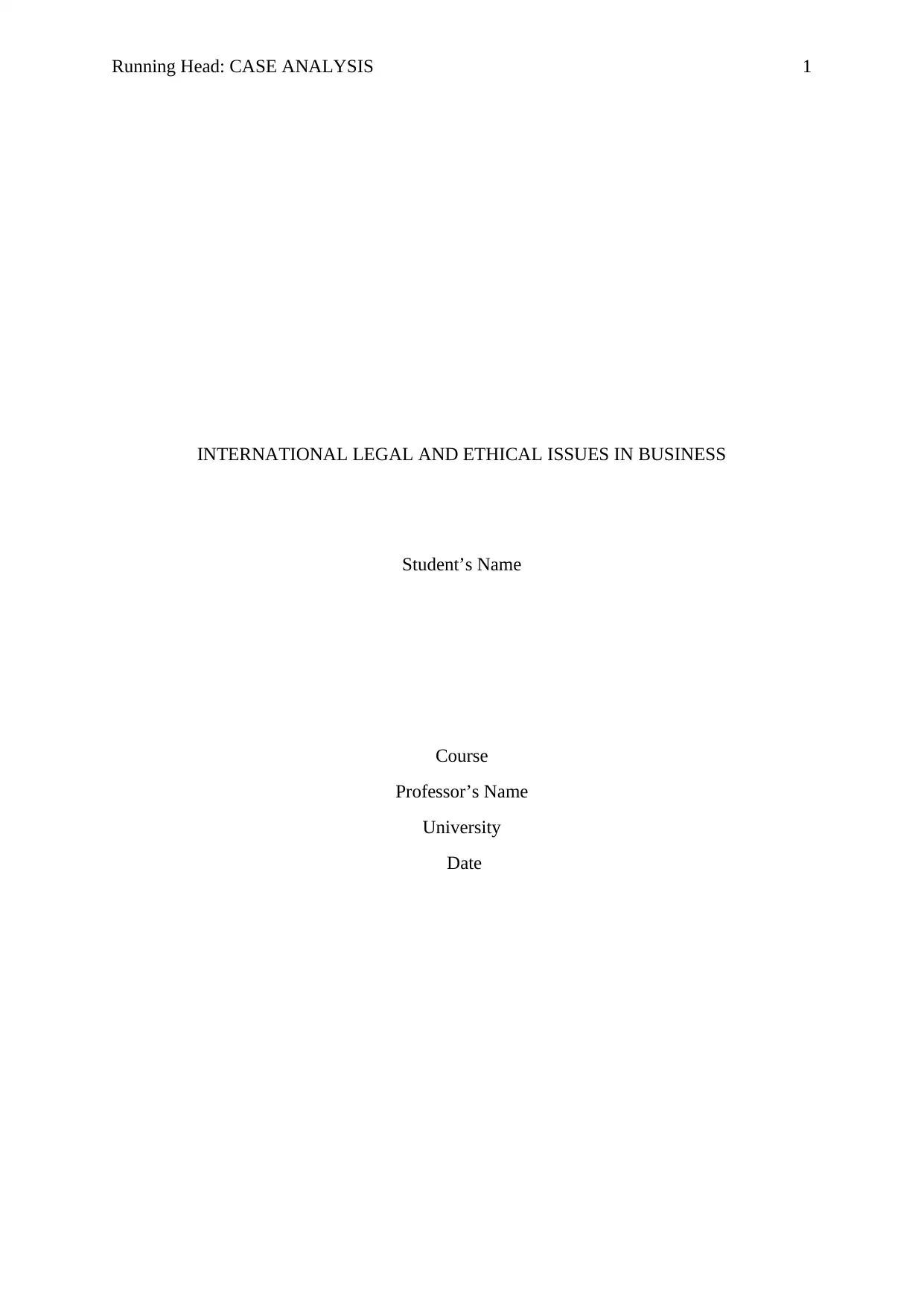
Running Head: CASE ANALYSIS 1
INTERNATIONAL LEGAL AND ETHICAL ISSUES IN BUSINESS
Student’s Name
Course
Professor’s Name
University
Date
INTERNATIONAL LEGAL AND ETHICAL ISSUES IN BUSINESS
Student’s Name
Course
Professor’s Name
University
Date
Paraphrase This Document
Need a fresh take? Get an instant paraphrase of this document with our AI Paraphraser
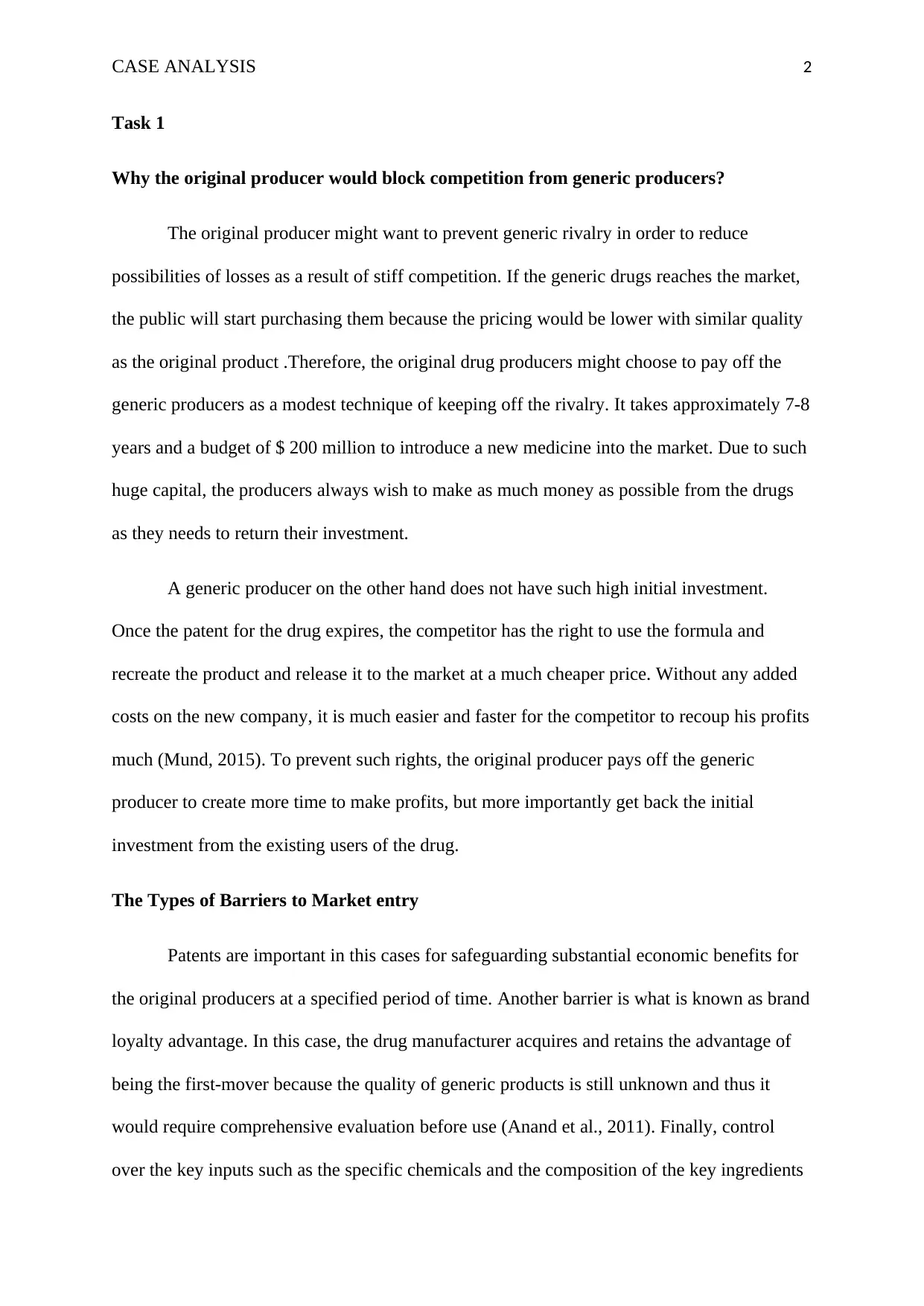
CASE ANALYSIS 2
Task 1
Why the original producer would block competition from generic producers?
The original producer might want to prevent generic rivalry in order to reduce
possibilities of losses as a result of stiff competition. If the generic drugs reaches the market,
the public will start purchasing them because the pricing would be lower with similar quality
as the original product .Therefore, the original drug producers might choose to pay off the
generic producers as a modest technique of keeping off the rivalry. It takes approximately 7-8
years and a budget of $ 200 million to introduce a new medicine into the market. Due to such
huge capital, the producers always wish to make as much money as possible from the drugs
as they needs to return their investment.
A generic producer on the other hand does not have such high initial investment.
Once the patent for the drug expires, the competitor has the right to use the formula and
recreate the product and release it to the market at a much cheaper price. Without any added
costs on the new company, it is much easier and faster for the competitor to recoup his profits
much (Mund, 2015). To prevent such rights, the original producer pays off the generic
producer to create more time to make profits, but more importantly get back the initial
investment from the existing users of the drug.
The Types of Barriers to Market entry
Patents are important in this cases for safeguarding substantial economic benefits for
the original producers at a specified period of time. Another barrier is what is known as brand
loyalty advantage. In this case, the drug manufacturer acquires and retains the advantage of
being the first-mover because the quality of generic products is still unknown and thus it
would require comprehensive evaluation before use (Anand et al., 2011). Finally, control
over the key inputs such as the specific chemicals and the composition of the key ingredients
Task 1
Why the original producer would block competition from generic producers?
The original producer might want to prevent generic rivalry in order to reduce
possibilities of losses as a result of stiff competition. If the generic drugs reaches the market,
the public will start purchasing them because the pricing would be lower with similar quality
as the original product .Therefore, the original drug producers might choose to pay off the
generic producers as a modest technique of keeping off the rivalry. It takes approximately 7-8
years and a budget of $ 200 million to introduce a new medicine into the market. Due to such
huge capital, the producers always wish to make as much money as possible from the drugs
as they needs to return their investment.
A generic producer on the other hand does not have such high initial investment.
Once the patent for the drug expires, the competitor has the right to use the formula and
recreate the product and release it to the market at a much cheaper price. Without any added
costs on the new company, it is much easier and faster for the competitor to recoup his profits
much (Mund, 2015). To prevent such rights, the original producer pays off the generic
producer to create more time to make profits, but more importantly get back the initial
investment from the existing users of the drug.
The Types of Barriers to Market entry
Patents are important in this cases for safeguarding substantial economic benefits for
the original producers at a specified period of time. Another barrier is what is known as brand
loyalty advantage. In this case, the drug manufacturer acquires and retains the advantage of
being the first-mover because the quality of generic products is still unknown and thus it
would require comprehensive evaluation before use (Anand et al., 2011). Finally, control
over the key inputs such as the specific chemicals and the composition of the key ingredients
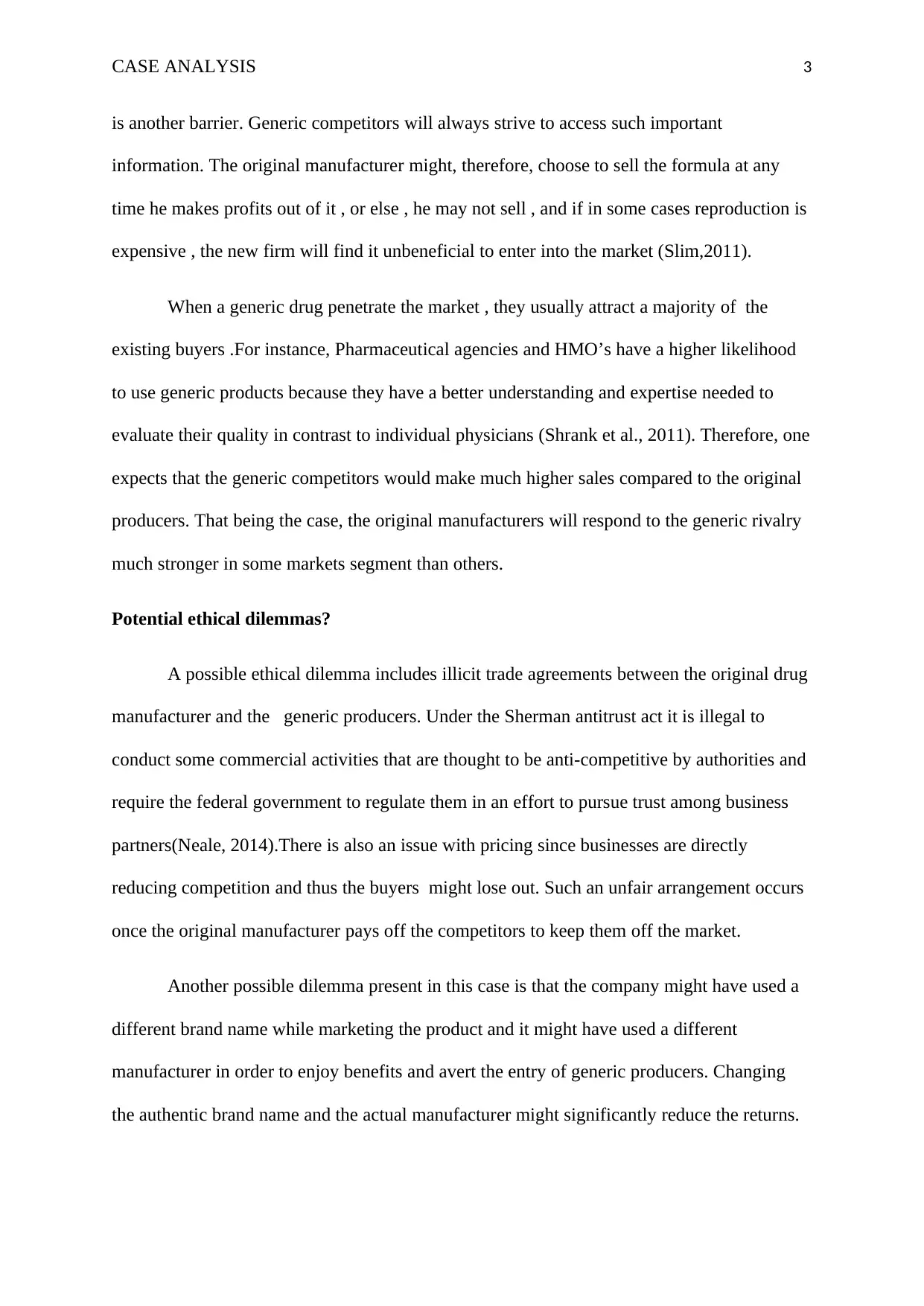
CASE ANALYSIS 3
is another barrier. Generic competitors will always strive to access such important
information. The original manufacturer might, therefore, choose to sell the formula at any
time he makes profits out of it , or else , he may not sell , and if in some cases reproduction is
expensive , the new firm will find it unbeneficial to enter into the market (Slim,2011).
When a generic drug penetrate the market , they usually attract a majority of the
existing buyers .For instance, Pharmaceutical agencies and HMO’s have a higher likelihood
to use generic products because they have a better understanding and expertise needed to
evaluate their quality in contrast to individual physicians (Shrank et al., 2011). Therefore, one
expects that the generic competitors would make much higher sales compared to the original
producers. That being the case, the original manufacturers will respond to the generic rivalry
much stronger in some markets segment than others.
Potential ethical dilemmas?
A possible ethical dilemma includes illicit trade agreements between the original drug
manufacturer and the generic producers. Under the Sherman antitrust act it is illegal to
conduct some commercial activities that are thought to be anti-competitive by authorities and
require the federal government to regulate them in an effort to pursue trust among business
partners(Neale, 2014).There is also an issue with pricing since businesses are directly
reducing competition and thus the buyers might lose out. Such an unfair arrangement occurs
once the original manufacturer pays off the competitors to keep them off the market.
Another possible dilemma present in this case is that the company might have used a
different brand name while marketing the product and it might have used a different
manufacturer in order to enjoy benefits and avert the entry of generic producers. Changing
the authentic brand name and the actual manufacturer might significantly reduce the returns.
is another barrier. Generic competitors will always strive to access such important
information. The original manufacturer might, therefore, choose to sell the formula at any
time he makes profits out of it , or else , he may not sell , and if in some cases reproduction is
expensive , the new firm will find it unbeneficial to enter into the market (Slim,2011).
When a generic drug penetrate the market , they usually attract a majority of the
existing buyers .For instance, Pharmaceutical agencies and HMO’s have a higher likelihood
to use generic products because they have a better understanding and expertise needed to
evaluate their quality in contrast to individual physicians (Shrank et al., 2011). Therefore, one
expects that the generic competitors would make much higher sales compared to the original
producers. That being the case, the original manufacturers will respond to the generic rivalry
much stronger in some markets segment than others.
Potential ethical dilemmas?
A possible ethical dilemma includes illicit trade agreements between the original drug
manufacturer and the generic producers. Under the Sherman antitrust act it is illegal to
conduct some commercial activities that are thought to be anti-competitive by authorities and
require the federal government to regulate them in an effort to pursue trust among business
partners(Neale, 2014).There is also an issue with pricing since businesses are directly
reducing competition and thus the buyers might lose out. Such an unfair arrangement occurs
once the original manufacturer pays off the competitors to keep them off the market.
Another possible dilemma present in this case is that the company might have used a
different brand name while marketing the product and it might have used a different
manufacturer in order to enjoy benefits and avert the entry of generic producers. Changing
the authentic brand name and the actual manufacturer might significantly reduce the returns.
⊘ This is a preview!⊘
Do you want full access?
Subscribe today to unlock all pages.

Trusted by 1+ million students worldwide
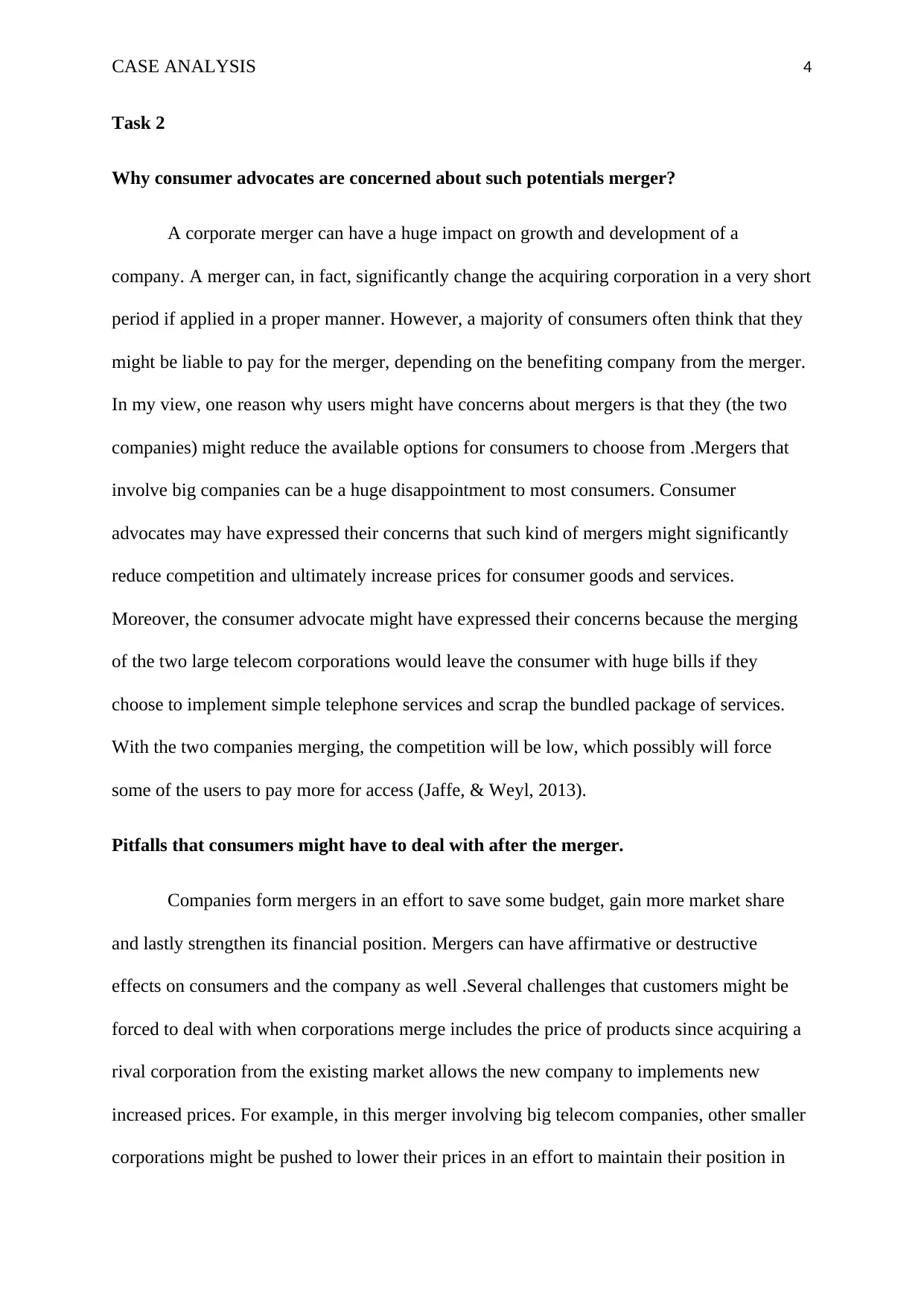
CASE ANALYSIS 4
Task 2
Why consumer advocates are concerned about such potentials merger?
A corporate merger can have a huge impact on growth and development of a
company. A merger can, in fact, significantly change the acquiring corporation in a very short
period if applied in a proper manner. However, a majority of consumers often think that they
might be liable to pay for the merger, depending on the benefiting company from the merger.
In my view, one reason why users might have concerns about mergers is that they (the two
companies) might reduce the available options for consumers to choose from .Mergers that
involve big companies can be a huge disappointment to most consumers. Consumer
advocates may have expressed their concerns that such kind of mergers might significantly
reduce competition and ultimately increase prices for consumer goods and services.
Moreover, the consumer advocate might have expressed their concerns because the merging
of the two large telecom corporations would leave the consumer with huge bills if they
choose to implement simple telephone services and scrap the bundled package of services.
With the two companies merging, the competition will be low, which possibly will force
some of the users to pay more for access (Jaffe, & Weyl, 2013).
Pitfalls that consumers might have to deal with after the merger.
Companies form mergers in an effort to save some budget, gain more market share
and lastly strengthen its financial position. Mergers can have affirmative or destructive
effects on consumers and the company as well .Several challenges that customers might be
forced to deal with when corporations merge includes the price of products since acquiring a
rival corporation from the existing market allows the new company to implements new
increased prices. For example, in this merger involving big telecom companies, other smaller
corporations might be pushed to lower their prices in an effort to maintain their position in
Task 2
Why consumer advocates are concerned about such potentials merger?
A corporate merger can have a huge impact on growth and development of a
company. A merger can, in fact, significantly change the acquiring corporation in a very short
period if applied in a proper manner. However, a majority of consumers often think that they
might be liable to pay for the merger, depending on the benefiting company from the merger.
In my view, one reason why users might have concerns about mergers is that they (the two
companies) might reduce the available options for consumers to choose from .Mergers that
involve big companies can be a huge disappointment to most consumers. Consumer
advocates may have expressed their concerns that such kind of mergers might significantly
reduce competition and ultimately increase prices for consumer goods and services.
Moreover, the consumer advocate might have expressed their concerns because the merging
of the two large telecom corporations would leave the consumer with huge bills if they
choose to implement simple telephone services and scrap the bundled package of services.
With the two companies merging, the competition will be low, which possibly will force
some of the users to pay more for access (Jaffe, & Weyl, 2013).
Pitfalls that consumers might have to deal with after the merger.
Companies form mergers in an effort to save some budget, gain more market share
and lastly strengthen its financial position. Mergers can have affirmative or destructive
effects on consumers and the company as well .Several challenges that customers might be
forced to deal with when corporations merge includes the price of products since acquiring a
rival corporation from the existing market allows the new company to implements new
increased prices. For example, in this merger involving big telecom companies, other smaller
corporations might be pushed to lower their prices in an effort to maintain their position in
Paraphrase This Document
Need a fresh take? Get an instant paraphrase of this document with our AI Paraphraser
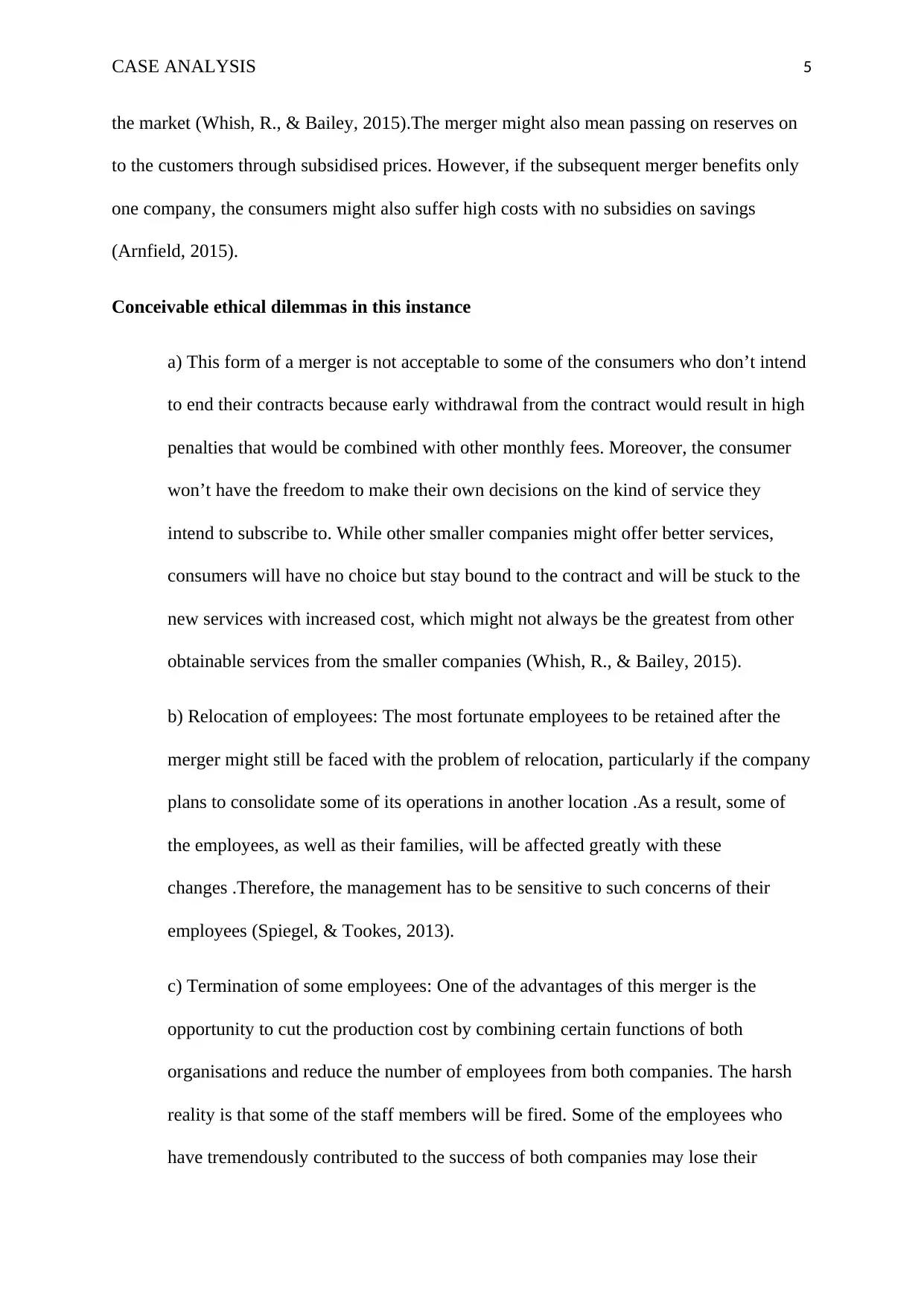
CASE ANALYSIS 5
the market (Whish, R., & Bailey, 2015).The merger might also mean passing on reserves on
to the customers through subsidised prices. However, if the subsequent merger benefits only
one company, the consumers might also suffer high costs with no subsidies on savings
(Arnfield, 2015).
Conceivable ethical dilemmas in this instance
a) This form of a merger is not acceptable to some of the consumers who don’t intend
to end their contracts because early withdrawal from the contract would result in high
penalties that would be combined with other monthly fees. Moreover, the consumer
won’t have the freedom to make their own decisions on the kind of service they
intend to subscribe to. While other smaller companies might offer better services,
consumers will have no choice but stay bound to the contract and will be stuck to the
new services with increased cost, which might not always be the greatest from other
obtainable services from the smaller companies (Whish, R., & Bailey, 2015).
b) Relocation of employees: The most fortunate employees to be retained after the
merger might still be faced with the problem of relocation, particularly if the company
plans to consolidate some of its operations in another location .As a result, some of
the employees, as well as their families, will be affected greatly with these
changes .Therefore, the management has to be sensitive to such concerns of their
employees (Spiegel, & Tookes, 2013).
c) Termination of some employees: One of the advantages of this merger is the
opportunity to cut the production cost by combining certain functions of both
organisations and reduce the number of employees from both companies. The harsh
reality is that some of the staff members will be fired. Some of the employees who
have tremendously contributed to the success of both companies may lose their
the market (Whish, R., & Bailey, 2015).The merger might also mean passing on reserves on
to the customers through subsidised prices. However, if the subsequent merger benefits only
one company, the consumers might also suffer high costs with no subsidies on savings
(Arnfield, 2015).
Conceivable ethical dilemmas in this instance
a) This form of a merger is not acceptable to some of the consumers who don’t intend
to end their contracts because early withdrawal from the contract would result in high
penalties that would be combined with other monthly fees. Moreover, the consumer
won’t have the freedom to make their own decisions on the kind of service they
intend to subscribe to. While other smaller companies might offer better services,
consumers will have no choice but stay bound to the contract and will be stuck to the
new services with increased cost, which might not always be the greatest from other
obtainable services from the smaller companies (Whish, R., & Bailey, 2015).
b) Relocation of employees: The most fortunate employees to be retained after the
merger might still be faced with the problem of relocation, particularly if the company
plans to consolidate some of its operations in another location .As a result, some of
the employees, as well as their families, will be affected greatly with these
changes .Therefore, the management has to be sensitive to such concerns of their
employees (Spiegel, & Tookes, 2013).
c) Termination of some employees: One of the advantages of this merger is the
opportunity to cut the production cost by combining certain functions of both
organisations and reduce the number of employees from both companies. The harsh
reality is that some of the staff members will be fired. Some of the employees who
have tremendously contributed to the success of both companies may lose their

CASE ANALYSIS 6
positions (Carlton, 2010). Therefore, the management tasked with the merger process
needs to deal with the uncomfortable moral issues of whether some of the employees
need to be fired of not.
positions (Carlton, 2010). Therefore, the management tasked with the merger process
needs to deal with the uncomfortable moral issues of whether some of the employees
need to be fired of not.
⊘ This is a preview!⊘
Do you want full access?
Subscribe today to unlock all pages.

Trusted by 1+ million students worldwide
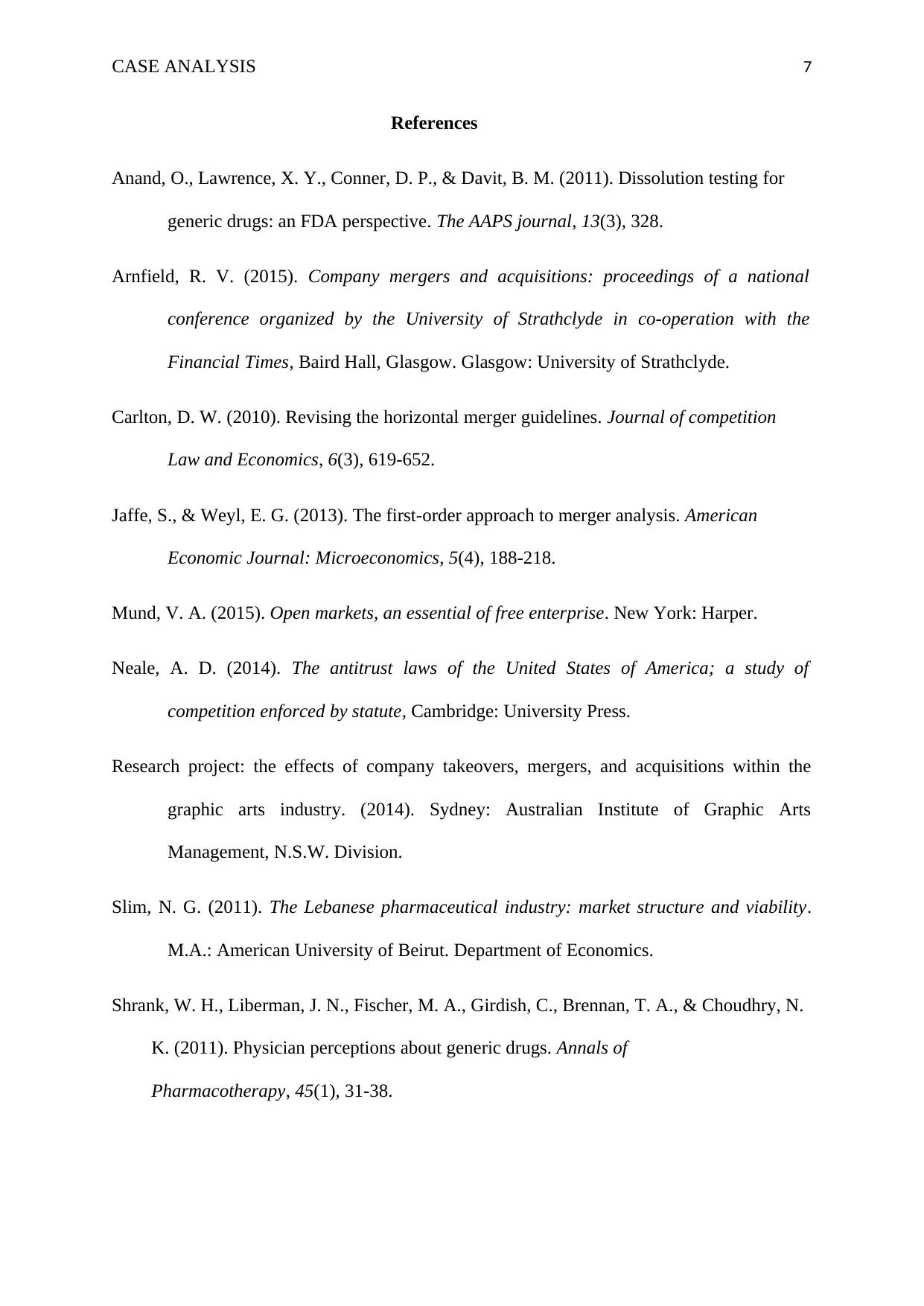
CASE ANALYSIS 7
References
Anand, O., Lawrence, X. Y., Conner, D. P., & Davit, B. M. (2011). Dissolution testing for
generic drugs: an FDA perspective. The AAPS journal, 13(3), 328.
Arnfield, R. V. (2015). Company mergers and acquisitions: proceedings of a national
conference organized by the University of Strathclyde in co-operation with the
Financial Times, Baird Hall, Glasgow. Glasgow: University of Strathclyde.
Carlton, D. W. (2010). Revising the horizontal merger guidelines. Journal of competition
Law and Economics, 6(3), 619-652.
Jaffe, S., & Weyl, E. G. (2013). The first-order approach to merger analysis. American
Economic Journal: Microeconomics, 5(4), 188-218.
Mund, V. A. (2015). Open markets, an essential of free enterprise. New York: Harper.
Neale, A. D. (2014). The antitrust laws of the United States of America; a study of
competition enforced by statute, Cambridge: University Press.
Research project: the effects of company takeovers, mergers, and acquisitions within the
graphic arts industry. (2014). Sydney: Australian Institute of Graphic Arts
Management, N.S.W. Division.
Slim, N. G. (2011). The Lebanese pharmaceutical industry: market structure and viability.
M.A.: American University of Beirut. Department of Economics.
Shrank, W. H., Liberman, J. N., Fischer, M. A., Girdish, C., Brennan, T. A., & Choudhry, N.
K. (2011). Physician perceptions about generic drugs. Annals of
Pharmacotherapy, 45(1), 31-38.
References
Anand, O., Lawrence, X. Y., Conner, D. P., & Davit, B. M. (2011). Dissolution testing for
generic drugs: an FDA perspective. The AAPS journal, 13(3), 328.
Arnfield, R. V. (2015). Company mergers and acquisitions: proceedings of a national
conference organized by the University of Strathclyde in co-operation with the
Financial Times, Baird Hall, Glasgow. Glasgow: University of Strathclyde.
Carlton, D. W. (2010). Revising the horizontal merger guidelines. Journal of competition
Law and Economics, 6(3), 619-652.
Jaffe, S., & Weyl, E. G. (2013). The first-order approach to merger analysis. American
Economic Journal: Microeconomics, 5(4), 188-218.
Mund, V. A. (2015). Open markets, an essential of free enterprise. New York: Harper.
Neale, A. D. (2014). The antitrust laws of the United States of America; a study of
competition enforced by statute, Cambridge: University Press.
Research project: the effects of company takeovers, mergers, and acquisitions within the
graphic arts industry. (2014). Sydney: Australian Institute of Graphic Arts
Management, N.S.W. Division.
Slim, N. G. (2011). The Lebanese pharmaceutical industry: market structure and viability.
M.A.: American University of Beirut. Department of Economics.
Shrank, W. H., Liberman, J. N., Fischer, M. A., Girdish, C., Brennan, T. A., & Choudhry, N.
K. (2011). Physician perceptions about generic drugs. Annals of
Pharmacotherapy, 45(1), 31-38.
Paraphrase This Document
Need a fresh take? Get an instant paraphrase of this document with our AI Paraphraser

CASE ANALYSIS 8
Spiegel, M., & Tookes, H. (2013). Dynamic competition, valuation, and merger activity. The
Journal of Finance, 68(1), 125-172.
Whish, R., & Bailey, D. (2015). Competition law. Oxford University Press, USA.
Spiegel, M., & Tookes, H. (2013). Dynamic competition, valuation, and merger activity. The
Journal of Finance, 68(1), 125-172.
Whish, R., & Bailey, D. (2015). Competition law. Oxford University Press, USA.
1 out of 8
Related Documents
Your All-in-One AI-Powered Toolkit for Academic Success.
+13062052269
info@desklib.com
Available 24*7 on WhatsApp / Email
![[object Object]](/_next/static/media/star-bottom.7253800d.svg)
Unlock your academic potential
Copyright © 2020–2025 A2Z Services. All Rights Reserved. Developed and managed by ZUCOL.





